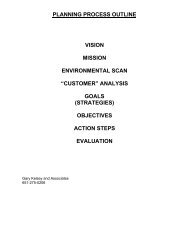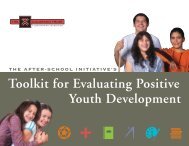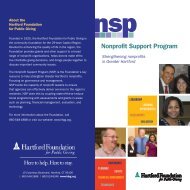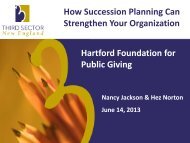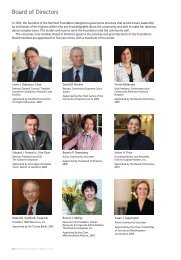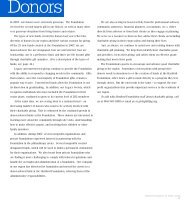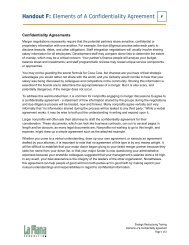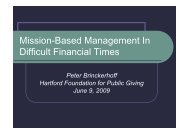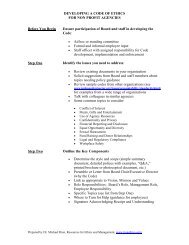Sustainable Leadership and Succession Planning Workshop
Sustainable Leadership and Succession Planning Workshop
Sustainable Leadership and Succession Planning Workshop
Create successful ePaper yourself
Turn your PDF publications into a flip-book with our unique Google optimized e-Paper software.
HARTFORD FOUNDATION FOR PUBLIC GIVING<br />
<strong>Sustainable</strong> <strong>Leadership</strong><br />
<strong>and</strong><br />
<strong>Succession</strong> <strong>Planning</strong> <strong>Workshop</strong><br />
Wednesday, December 12, 2007<br />
Presented by:<br />
Tom Adams, President<br />
Lisa Burford Hardmon, Consultant<br />
1751 Elton Road, Suite 204<br />
Silver Spring, MD 20782<br />
tadams@transitionguides.com<br />
lhardmon@transitionguides.com<br />
www.transitionguides.com<br />
Office: 301-439-6635<br />
Fax: 301-439-6638
Hartford Foundation for Public Giving<br />
<strong>Sustainable</strong> <strong>Leadership</strong> <strong>and</strong> <strong>Succession</strong> <strong>Planning</strong> <strong>Workshop</strong><br />
December 12, 2007<br />
Agenda<br />
Session Goals: The workshop will provide participants with the following:<br />
1. An introduction to succession planning <strong>and</strong> executive transition management<br />
2. An underst<strong>and</strong>ing of different types of succession plans<br />
3. An underst<strong>and</strong>ing of how organizations can benefit by reducing the risk of unplanned<br />
leadership transitions <strong>and</strong> a guide for developing a plan<br />
4. A review of sample emergency succession plan<br />
9:00 AM Welcome, Agenda Review <strong>and</strong> Introductions<br />
9:25 AM<br />
Overview of Executive Transition Management <strong>and</strong> <strong>Leadership</strong> Sustainability <strong>and</strong> ,<br />
<strong>Succession</strong> <strong>Planning</strong><br />
9:55 AM<br />
Underst<strong>and</strong>ing your Organization’s Context: Reflections on Direction <strong>and</strong> Priorities<br />
for <strong>Leadership</strong> <strong>Planning</strong><br />
10:15 AM<br />
Small Group Discussions: <strong>Succession</strong> <strong>Planning</strong> <strong>and</strong> Executive Transition<br />
Management (Optional – Can continue to meet with your team if you elect)<br />
10:35 AM Break<br />
10:45 AM Short Report Outs <strong>and</strong> Q & A<br />
11:00 AM Emergency Back-Up <strong>Planning</strong>: Getting Started <strong>and</strong> Exploration of Important Actions<br />
11:30 AM Report Out: Ah-ha’s <strong>and</strong> Next Steps on Action Items<br />
11:45 AM Wrap Up <strong>and</strong> Session Evaluation<br />
12:00 PM Adjourn
Table of Contents<br />
PowerPoint Presentation<br />
…… 1<br />
SECTION ONE: SESSION MATERIALS …… 9<br />
Direction, <strong>Leadership</strong> <strong>and</strong> Change …… 11<br />
Assessing <strong>and</strong> Building the <strong>Leadership</strong> Capacity of Staff <strong>and</strong> the Board …… 13<br />
Underst<strong>and</strong>ing the Leader Development & <strong>Succession</strong> L<strong>and</strong>scape …… 15<br />
Leader Development …… 16<br />
Template: Emergency <strong>Succession</strong> Plan For The Executive* …… 17<br />
Reflections: Key Questions to Consider …… 21<br />
SECTION TWO: ABOUT TRANSITIONGUIDES …… 23<br />
TransitionGuides Overview …… 25<br />
TransitionGuides <strong>Leadership</strong> Transition Management Overview …… 27<br />
TransitionGuides Education Overview …… 29<br />
Biography: Tom Adams & Lisa Burford Hardmon …… 31<br />
SECTION THREE: RESOURCES …… 35<br />
TransitionGuides Bibliography Summary …… 37<br />
Session Materials Sign Up Form …… 41<br />
SECTION FOUR: EVALUATION …… 43<br />
<strong>Workshop</strong> Evaluation …… 45<br />
* Excerpt from Leader Development & Emergency <strong>Succession</strong> <strong>Planning</strong>. See www.transitionguides.com to obtain a compact disk (CD-Rom) of the full workbook..
POWERPOINT PRESENTATION
<strong>Succession</strong> <strong>Planning</strong> <strong>and</strong> Executive<br />
Transition Management<br />
Hartford<br />
Tom<br />
Lisa Burford Hardmon, MNO<br />
LHardmon@transitionguides.com<br />
1751 Elton Road, 204<br />
Silver Spring, MD 20903<br />
Office: 301-439-6635<br />
Web: www.transitionguides.com<br />
Email: info@transitionguides.com<br />
Premise:<br />
• When assessing an organization’s effectiveness<br />
in mission accomplishment, there is a<br />
discernable LINK connecting<br />
» Mission<br />
» Organizational Effectiveness<br />
» Sustainability<br />
• The LINK is …<strong>Leadership</strong> Capacity to facilitate<br />
Organizational Performance<br />
• The Desired Result …effective, sustainable <strong>and</strong><br />
strong organizations<br />
Terminology<br />
• <strong>Succession</strong> planning<br />
• Sustainability planning<br />
• Legacy planning<br />
• Executive transition<br />
• Executive search<br />
• Executive transition management<br />
• Interim Executive<br />
1
Transition – Coming to Terms with Change<br />
Ending:<br />
Loss<br />
Letting Go<br />
Relinquishing Old Way<br />
& Old Identity<br />
Neutral Zone:<br />
Confusion<br />
Direction Finding<br />
Re-patterning<br />
New Beginning:<br />
Commitment<br />
Rebirth<br />
New Energy<br />
New Sense of Purpose<br />
Source: Bridges, William. Managing Transitions: Making the Most of Change.<br />
2nd ed. Cambridge, MA: Perseus Pub., 2003.<br />
Why Plan for <strong>Succession</strong>?<br />
Advanced planning for changes in<br />
leadership helps to minimize risk<br />
during transitions, <strong>and</strong> supports<br />
organizational sustainability.<br />
Two Philosophical Approaches <strong>Leadership</strong><br />
Development <strong>and</strong> <strong>Succession</strong> <strong>Planning</strong><br />
1.Replacement - Filling a position after the<br />
planned or unplanned departure of a leader.<br />
2.Leader-Development – An ongoing<br />
strategic approach to talent management that puts<br />
people with the right skills & abilities into leadership<br />
roles in a timely fashion for the organization & the<br />
individual’s development.<br />
2
Three Types of <strong>Succession</strong> Plans:<br />
• Emergency:<br />
– Prepares organization for unexpected transitions<br />
• Short-term “stop gap” measure<br />
• Longer-term replacement strategy<br />
• Strategic Development:<br />
– An investment in leader development over time to<br />
• Broaden <strong>and</strong> sustain leadership capacity<br />
• Support professional development of Board <strong>and</strong> staff<br />
• Departure Defined:<br />
– An approach often preferred by founders <strong>and</strong> longtenured<br />
executives to engage the Board <strong>and</strong> staff in a<br />
more public succession planning (with the anticipation<br />
of leaving at a certain time).<br />
Emergency <strong>Succession</strong> <strong>Planning</strong><br />
Critical Elements<br />
• Underst<strong>and</strong> the Key Functions, Roles & Relationships of<br />
the Executive<br />
• Designate back-up coverage in case of unplanned<br />
absence<br />
• Develop & Implement Cross-Training Opportunities<br />
• Develop Definitions, Procedures & Protocols for<br />
integrated Staff <strong>and</strong> Board Emergency Response (e.g.<br />
what, when, who <strong>and</strong> how)<br />
• Develop Transition Management Policy<br />
• Prioritize Capacity Building to Continue Positioning for<br />
Effective Transition Management<br />
• Circulate, review <strong>and</strong> refresh annually<br />
Strategic Leader Development <strong>Planning</strong><br />
Critical Elements<br />
• Convene Strategic Visioning or <strong>Planning</strong><br />
• Develop Agreement on Strategic Direction<br />
• Underst<strong>and</strong> the dominant Organization Culture <strong>and</strong><br />
Driving Forces<br />
• Underst<strong>and</strong> the Key Functions, Roles & Relationships<br />
of the Executive & other key leaders<br />
• Develop annual leadership recruitment <strong>and</strong><br />
development plan <strong>and</strong> integrate into ongoing strategic<br />
planning<br />
• Review <strong>and</strong> refresh annually<br />
3
Departure Defined <strong>Planning</strong><br />
Critical Elements<br />
• Executive does personal planning <strong>and</strong> decides on<br />
timeline for departure; coaching <strong>and</strong>/or Next Steps<br />
workshop may be helpful<br />
• Decide on when departure announcement is public<br />
<strong>and</strong> priority actions before departure<br />
• Inform Board leaders <strong>and</strong> form <strong>and</strong> convene<br />
Transition Committee when appropriate<br />
• Design Transition Management Process (see<br />
previous ETM slides)<br />
• EMBRACE THE JOURNEY<br />
Overview:<br />
Executive Transition Management (ETM)<br />
Executive Transition Continuum<br />
PREPARE PIVOT THRIVE<br />
Launch & Support<br />
Departure-Defined <strong>Succession</strong><br />
<strong>Planning</strong><br />
Clarify Transition <strong>Leadership</strong><br />
Stabilize Situati on (if needed)<br />
Plan Search & Transition<br />
Search & Select<br />
Prepare Organization<br />
Organizational Capacity<br />
Leader Development <strong>Planning</strong><br />
1-3 Years<br />
4-6 Months One Budget Cycle<br />
4
Why Should We be Concerned?<br />
• Risk<br />
– Non-routine transitions<br />
– High turnover potential<br />
– <strong>Leadership</strong> & management shortage<br />
– Organizational instability or death<br />
• Cost<br />
– Community not served well or services interrupted<br />
– Loss of time <strong>and</strong> focus by board & staff<br />
– Funder retreat or suspension<br />
– Stakeholders investment lost or under used<br />
– Missed opportunities for projects or advances<br />
• Opportunity<br />
– Better match of <strong>Leadership</strong> Team with organizational direction <strong>and</strong> goals<br />
– Board development <strong>and</strong> strengthening<br />
– Exp<strong>and</strong>ed diversity in <strong>Leadership</strong> Team<br />
– Increased stakeholder support<br />
– Sustained or increased organizational effectiveness<br />
• Executive transitions are on the increase<br />
Executive Transitions on the Rise<br />
Range of Executives <strong>Planning</strong> to<br />
Leave in 2 <strong>and</strong> 5 years<br />
Leaving within 5<br />
Years<br />
From 61%-78%<br />
Leaving within 2<br />
years<br />
From 15%-35%<br />
0% 20% 40% 60% 80% 100%<br />
According to 3 recent surveys<br />
What is an Executive Transition?<br />
• Executive Transition—<br />
– Begins with the executive’s decision to depart<br />
(or the Board’s decision to terminate)<br />
– Extends through the recruitment <strong>and</strong> hiring<br />
– Concludes with completion of first full budget cycle<br />
with new executive<br />
• Executive Transition Management (ETM)—<br />
– A three-phase approach--<br />
• <strong>Planning</strong> & Preparation<br />
• Recruitment/Selection & Platform Building<br />
• Post-Hire Installation & Support<br />
– Holistic management of entire departure-recruitmentinstallation<br />
process<br />
5
Objective of Executive Transition<br />
Management<br />
– A positive, forward-looking relationship …<br />
– between an executive who fits the current <strong>and</strong><br />
future leadership needs of the organization<br />
<strong>and</strong>…<br />
– an organization (<strong>and</strong> board) that is prepared to<br />
work with him/her.<br />
– In other words, <strong>and</strong> executive who fits, sticks<br />
<strong>and</strong> performs.<br />
Factors Influencing Transition<br />
Organization health & life cycle<br />
Organization size<br />
Organization mission & culture<br />
Diversity considerations<br />
Departing executive’s role, legacy &<br />
shadow<br />
Circumstances of the departure<br />
Transition Scenarios – Related ED Challenges<br />
Start Up<br />
Turn Around<br />
Realignment<br />
Sustain Success<br />
Founder & Longterm<br />
ED<br />
• Insufficient salary for level of expertise needed<br />
• Role clarification<br />
• Reenergizing demoralized staff & stakeholders<br />
• Restoring reputation, improving accountability<br />
• Rebuilding systems, restoring service delivery<br />
• Lack of recognition that organization has “peaked”<br />
• Strategy, systems & culture “behind the times”<br />
• Finding a way to build on success<br />
• Creating your own leadership profile<br />
• Living with someone else’s team<br />
• Intertwined identities & relationships<br />
• Departure circumstances/timing<br />
• Former ED’s “power shadow”<br />
6
Executive Transition Management Process<br />
Overview<br />
PREPARE PIVOT THRIVE<br />
Searc h & Sele ct<br />
Intake &<br />
Contrac ting<br />
Plan S earch<br />
& Transition<br />
L aunch &<br />
Support<br />
Wrap Up<br />
Clarify<br />
Transition<br />
Leaders hip<br />
Stabilize<br />
Situation<br />
(if needed)<br />
Prepare<br />
Organization<br />
Target Result<br />
A positive, forward-looking relationship<br />
between an executive who fits the current <strong>and</strong> future leadership needs<br />
of the organization<br />
<strong>and</strong> an organization (including the board) that is prepared to work with him/her.<br />
7
Section One<br />
SESSION MATERIALS
Direction, <strong>Leadership</strong> <strong>and</strong> Change<br />
This worksheet is designed to have you continue to think about the organization, your vision <strong>and</strong><br />
aspirations for the future, as well as the leadership implications for you as a facilitator of<br />
constructive change.<br />
Based upon your mission, programs, <strong>and</strong> organizational capacity, describe your<br />
organization’s current <strong>and</strong>/or envisioned strategic direction <strong>and</strong> key goals<br />
(including timeframe for accomplishing goals)<br />
What are some of the fundamental issues <strong>and</strong>/or key concerns you have about<br />
moving your organization forward in this direction?<br />
What changes within the organizational culture, if any, do you anticipate might be<br />
needed as you move forward?<br />
What could be some advantages associated with moving your organization in this<br />
strategic direction?<br />
11
In order to move your organization forward … what are the 3 most critical changes<br />
that need to occur?<br />
Critical Changes<br />
For ED & Staff<br />
Implications<br />
For Board<br />
How would you describe the “BIG Change” for your organization?<br />
What are the desired gains? Potential risks/challenges?<br />
12
Assessing <strong>and</strong> Building the <strong>Leadership</strong> Capacity<br />
of Staff <strong>and</strong> the Board<br />
Reflections: Think about how work gets accomplished in your organization, <strong>and</strong> how<br />
perspectives or opinions are shaped. Use the questions below to identify leader-development<br />
opportunities within your organization.<br />
What is my organization’s leadership capacity?<br />
<br />
Who are the formal <strong>and</strong> informal leaders among staff? What are their strengths? In<br />
what ways would you like to see them develop/refine their leadership skills?<br />
<br />
Who are the formal <strong>and</strong> informal leaders among the board members? What are<br />
their strengths? In what ways would you like to see them develop/refine their<br />
leadership skills?<br />
What type of succession planning exists, or needs to be developed?<br />
<br />
For the Board:<br />
If the current officers are absent (long-/short-term), who is next in line to assume that<br />
responsibility? How prepared are they to assume the responsibility of leadership?<br />
<br />
For the Executive Director? For other Staff?<br />
13
Organizational <strong>Planning</strong> Workbook: Leader Development & Emergency <strong>Succession</strong><br />
<strong>Planning</strong><br />
Underst<strong>and</strong>ing the Leader Development & <strong>Succession</strong> L<strong>and</strong>scape<br />
In most literature that deals with succession planning <strong>and</strong> talent management, the models represented are<br />
heavily weighted toward for-profit corporate models. The interest in creating <strong>and</strong> sustaining a pipeline of<br />
viable leaders (staff <strong>and</strong> volunteers) within non-profit organizations is beginning to grow. Admittedly the<br />
resources to plan <strong>and</strong> implement leader development strategies may be difficult among non-profits because<br />
of competing dem<strong>and</strong>s for limited resources. However, the consequences of NOT developing an<br />
appropriate pipeline of staff <strong>and</strong> board leaders to implement key functions <strong>and</strong> fulfill critical responsibilities<br />
may contribute to the demise of some organizations.<br />
What if …?<br />
What would happen if the Executive Director leaves through an unplanned <strong>and</strong> unexpected way (say due to health).<br />
Who within the organization is prepared to step into that role <strong>and</strong> maintain the relationships with funders, community<br />
leaders <strong>and</strong> other stakeholders? Who in the organization would be prepared to provide appropriate oversight <strong>and</strong><br />
direction regarding the organization’s operations, programs <strong>and</strong> board liaison responsibilities?<br />
Whether the shift in leadership is unplanned/unexpected or predictable <strong>and</strong> planned, that transition<br />
between leaders can leave an organization in a vulnerable state. Loss of confidence in the organization’s<br />
ability to fulfill commitments, respond to the needs of programs <strong>and</strong> the communities served, etc. could<br />
significantly hamper an organization’s reputation <strong>and</strong> longer-term viability. The ability to recover (more<br />
quickly than not) from the shock of leader transition can be supported by having a plan <strong>and</strong> implementation<br />
strategy to have key functions <strong>and</strong> responsibilities “covered” by an alternate leader if the primary is unable<br />
to fulfill his/her responsibilities.<br />
Henry Kissinger said, “The task of the leader is to get [his/her] people from where they are to where they<br />
have not been.” It is important for leaders to prepare for leadership transitions before one occurs!<br />
<strong>Planning</strong>, persistence <strong>and</strong> creating opportunities to cultivate <strong>and</strong> exp<strong>and</strong> the talent within an organization<br />
can happen in small incremental ways as preparation for the day when the transition will occur.<br />
Two Philosophies Regarding <strong>Succession</strong> <strong>Planning</strong><br />
Replacement<br />
Traditionally, many of talent management <strong>and</strong> succession strategies have been built upon a<br />
“replacement” philosophy. There is validity to this, especially in a nonprofit context, when you are<br />
dealing with unplanned, unexpected changes in leaders. The immediate questions of within the<br />
organization will be:<br />
<br />
<br />
<br />
If the Executive, or a person any other key role, leaves unexpectedly … who knows how to do that<br />
function?<br />
Who underst<strong>and</strong>s what the immediate organization/program needs are – <strong>and</strong> how to meet those<br />
needs/commitments?<br />
If someone else on staff moves to take on these additional responsibilities, what other parts of the<br />
organization may suffer due to lack of, or insufficient, attention?
Organizational <strong>Planning</strong> Workbook: Leader Development & Emergency <strong>Succession</strong><br />
<strong>Planning</strong><br />
Leader Development<br />
An emerging philosophy to address some of these key questions articulated above, is talent management<br />
through “on-going leader development.” This philosophy emphasizes the need to attend to staff<br />
development <strong>and</strong> board development activities in order to create <strong>and</strong> maintain a pipeline of people capable<br />
of taking on various leadership responsibilities needed within the organization, on a short or longer-term<br />
basis. This includes both strategic <strong>and</strong> intentional focus on:<br />
examining current status of skills, competencies <strong>and</strong> abilities among staff <strong>and</strong> volunteers (board)<br />
creating a plan that covers the key management/program roles (in emergency cases)<br />
creating a plan that develops talent over time to step into leader roles (staff or volunteer) when needed<br />
implementing strategies to support these plans<br />
In this emerging philosophy of leader development-succession planning, the strategies used to implement<br />
these plans need to be woven into the infrastructure of the organization’s systems, policies <strong>and</strong> day-to-day<br />
practices. Resources to sustain a leader development-succession plan should be appropriate <strong>and</strong><br />
commensurate with the scale of the organization’s budget realities. Crafting a communication strategy for<br />
internal <strong>and</strong> external stakeholders about the leader development plans will help educate, motivate <strong>and</strong><br />
enroll support for your plans.<br />
Types of <strong>Succession</strong> Plans<br />
Type Characteristics When & Why<br />
A replacement approach that prepares the<br />
organization for unexpected transitions. In<br />
addition to placing an alternate person in a<br />
position, it also requires clarifying the lines of<br />
authority within the organization (within the<br />
context of this new scenario) <strong>and</strong> communication<br />
to educate key strategy (internal & external)<br />
stakeholders <strong>and</strong> to enroll their support with this<br />
change.<br />
EMERGENCY<br />
STRATEGIC<br />
DEVELOPMENT<br />
DEPARTURE-DEFINED<br />
A longer-term investment in leader development<br />
that is incorporated into the strategic business<br />
planning of the organization. It is a proactive<br />
approach that broadens leadership capacity<br />
through attention to cross-training, <strong>and</strong> the<br />
professional development of staff <strong>and</strong> board<br />
leaders.<br />
An approach often preferred by founders <strong>and</strong><br />
long-tenured executives where the executive<br />
might initiate changes that are preparing for<br />
succession privately, <strong>and</strong> then engage the Board<br />
<strong>and</strong> staff in a more public succession planning<br />
process. This may occur 1.5 to 3 years before<br />
the executive’s anticipated departure.<br />
When a leader (e.g., CEO, other KEY<br />
role, Board Officer) departs<br />
unexpectedly, usually due to death<br />
or illness). This could be used as a<br />
short-term “stop gap” measure to<br />
sustain viability for short-term<br />
illnesses, or for longer-term use<br />
when it will take time to replace the<br />
person in that role.<br />
An investment in leader<br />
development over time that is<br />
designed to create <strong>and</strong> maintain<br />
breadth <strong>and</strong> depth of leadership<br />
capacity for important staff roles <strong>and</strong><br />
for the leadership of the board.<br />
This could be a hybrid of the<br />
emergency <strong>and</strong>/or strategic<br />
development succession plans. This<br />
is used in short- or long-term<br />
replacement for planned departures<br />
of people in key roles.<br />
© 2003 – JLH Associates & TransitionGuides<br />
16
Reflections<br />
Key Questions to Consider<br />
1. Do you have a current Executive Director job description? Yes No<br />
If not, what’s your process <strong>and</strong> timeline for developing one?<br />
2. Is there an obvious back-up person for the executive director? Yes No<br />
If not, what are the options <strong>and</strong> your process <strong>and</strong> timeline for deciding?<br />
3. Do you have an emergency back-up (succession) plan in place? Yes No<br />
If not, what’s your process <strong>and</strong> timeline for development <strong>and</strong> what assistance<br />
is needed?<br />
4. Are there other staff or Board positions for which an emergency back-up plan<br />
is needed? Yes No<br />
If yes, for whom? _______________________<br />
What is the timeline for completion, if not in place?<br />
5. Is there a database or list for commu nications to key stakeholders that could<br />
be easily accessed to inform about an unplanned or planned absence? Yes No<br />
If yes, who keeps it <strong>and</strong> is responsible for updating? Name: ____________________<br />
If not, what’s your process <strong>and</strong> timeline for developing <strong>and</strong> making it available?<br />
21
Section Two<br />
ABOUT TRANSITIONGUIDES
Your Organization<br />
Makes a Difference<br />
TransitionGuides Makes Sure<br />
You Always Can<br />
Thriving organizations share three core elements: strong leadership, clear<br />
vision, <strong>and</strong> effective strategy. A change in executive leadership presents a change<br />
in all three. It’s a pivot point, a time when the organization’s future is on the line.<br />
An experienced adviser can help you make the most of this defining moment.<br />
Trust in a partner – one who believes in the possibilities <strong>and</strong> is well-versed in<br />
managing successful transitions – to enable you to navigate change <strong>and</strong> to help<br />
your organization exp<strong>and</strong> its scope, leverage talent, <strong>and</strong> increase mission results.<br />
Successfully led founder transition of leading Maryl<strong>and</strong> human services <strong>and</strong> advocacy organization<br />
Harness Your Strength<br />
TransitionGuides is a unique<br />
consulting <strong>and</strong> educational<br />
services company that enables<br />
nonprofit organizations to<br />
capitalize on opportunities<br />
that come with transitions.<br />
Headquartered in suburban<br />
Washington, DC, our team<br />
of nationally recognized<br />
consultants specializes in<br />
leadership transitions, succession<br />
planning, strategy development,<br />
<strong>and</strong> managing organizational<br />
change. We have successfully<br />
led hundreds of organizations<br />
through leadership <strong>and</strong> other<br />
pivotal changes. Clients include<br />
local <strong>and</strong> national nonprofits,<br />
foundations, associations, <strong>and</strong><br />
select government agencies.<br />
TransitionGuides is a pioneer in<br />
leading organizations to identify<br />
<strong>and</strong> harness the power of change.<br />
Built management team of<br />
nation’s largest neighborhood<br />
housing organization<br />
Launch Your Future<br />
TransitionGuides partners<br />
with organizations to facilitate<br />
transformation during a<br />
transition. Working h<strong>and</strong>in-h<strong>and</strong><br />
with your leadership<br />
team, we help you connect with<br />
the untapped potential of your<br />
mission, manage change, <strong>and</strong><br />
help you create an environment<br />
in which your organization can<br />
thrive. Executive searches are<br />
at the center of our services,<br />
but our knowledgebase of over<br />
200 engagements has taught us<br />
that a leadership transition is an<br />
arc of events that encompasses<br />
much more than the search. A<br />
successful transition requires<br />
sophisticated planning,<br />
thoughtful implementation of the<br />
launch, <strong>and</strong> significant support<br />
after the executive is hired. Our<br />
services offer a complete solution<br />
to the challenge <strong>and</strong> opportunity<br />
of leadership transition <strong>and</strong><br />
were specifically developed<br />
with the nonprofit sector in<br />
mind. With a committed partner<br />
<strong>and</strong> expert services, change<br />
becomes a catalyst for growth.<br />
Lead with Experience<br />
Founded by leaders in the area of<br />
executive transition for nonprofit<br />
organizations, TransitionGuides<br />
offers a diverse <strong>and</strong> talented<br />
national network of professionals.<br />
Our team of consultants has<br />
broad <strong>and</strong> deep experience, <strong>and</strong><br />
each one came from a successful<br />
career as an executive or senior<br />
level manager in the nonprofit<br />
sector. Our commitment to our<br />
clients goes beyond helping<br />
you find the right leadership.<br />
At TransitionGuides, our goal<br />
is to infuse your organization<br />
with new vitality, increasing<br />
your ability to make an impact<br />
now <strong>and</strong> in the future.<br />
Developed leadership<br />
transition initiatives for the<br />
Annie E. Casey Foundation<br />
<strong>and</strong> statewide associations<br />
TransitionGuides | 1751 Elton Road, Suite 204 | Silver Spring, MD 20903<br />
Phone 301-439-6635 | Fax 301-439-6638 | info@transitionguides.com | www.transitionguides.com 25
<strong>Leadership</strong><br />
Transition Services<br />
Your Organization Makes a Difference<br />
TransitionGuides Makes Sure<br />
You Always Can<br />
Turnover in executive leadership can be transforming. Positive transitions<br />
require effective management from start to finish. Few organizations<br />
successfully navigate this process alone. At TransitionGuides, we partner with<br />
organizations to capitalize on opportunities <strong>and</strong> mitigate risks that come with<br />
change. With extensive experience in change management, TransitionGuides<br />
utilizes a client-tailored approach that enables organizations to:<br />
· Clarify issues <strong>and</strong> direction<br />
· Successfully plan <strong>and</strong> manage leadership transition<br />
· Recruit, hire, <strong>and</strong> deploy exceptional leadership talent<br />
· Increase mission impact <strong>and</strong> enhance strategy, leadership, <strong>and</strong> capacity<br />
Successfully led turnaround project for a Maryl<strong>and</strong> youth organization in crisis<br />
More Results, More Impact<br />
TransitionGuides is a unique<br />
consulting <strong>and</strong> educational<br />
services company that enables<br />
organizations to capitalize on<br />
opportunities that come with<br />
transitions. Headquartered in<br />
suburban Washington, DC, our<br />
team of nationally recognized<br />
consultants specializes in leadership<br />
transitions, succession planning,<br />
strategy development, <strong>and</strong> managing<br />
organizational change. We have<br />
successfully led hundreds of<br />
organizations through leadership<br />
<strong>and</strong> other pivotal changes. Clients<br />
include local <strong>and</strong> national nonprofits,<br />
foundations, associations, <strong>and</strong><br />
select government agencies.<br />
TransitionGuides is a pioneer in<br />
leading organizations to identify<br />
<strong>and</strong> harness the power of change.<br />
Helped an association of grantmakers<br />
bridge a leadership gap <strong>and</strong><br />
successfully launch a new executive<br />
Align Your <strong>Leadership</strong>’s Power with<br />
<strong>Leadership</strong> Transition Management Services<br />
Executive Search <strong>and</strong> Transition Management<br />
Ensure a great hire <strong>and</strong> the successful launch of an executive<br />
who fits your organization’s current <strong>and</strong> future leadership<br />
needs. TransitionGuides collaborates with the leadership of<br />
your organization to develop a comprehensive set of services<br />
tailored to your needs. The program’s centerpiece is the<br />
presentation of excellent c<strong>and</strong>idates, but the process begins<br />
with the development of a sophisticated transition <strong>and</strong> search<br />
plan <strong>and</strong> ends in the selection of a new executive, who has a<br />
clear achievement roadmap <strong>and</strong> support for a positive start.<br />
<strong>Succession</strong> <strong>Planning</strong> Consultation<br />
Prepare for future transition by proactively<br />
establishing a leader development culture <strong>and</strong><br />
succession plans for key leadership positions.<br />
Executive Coaching<br />
Lead your organization through change or carefully plan for<br />
an imminent transition. Designed for founders <strong>and</strong> long-term<br />
executives. Post-hire support for new directors is also available.<br />
Capacity Building <strong>and</strong> <strong>Planning</strong><br />
Ensure a successful transition through strategic review <strong>and</strong><br />
planning, governance enhancement, <strong>and</strong> related staff <strong>and</strong><br />
organizational development.<br />
Guided a premier Virginia homeless program through<br />
executive transition after a legendary founder’s departure<br />
TransitionGuides | 1751 Elton Road, Suite 204 | Silver Spring, MD 20903<br />
Phone 301-439-6635 | Fax 301-439-6638 | info@transitionguides.com | www.transitionguides.com 27
Knowledge Development<br />
<strong>and</strong> Education<br />
Your Organization Makes a Difference<br />
TransitionGuides Makes Sure<br />
You Always Can<br />
<strong>Leadership</strong> transitions are pivotal moments you can use to clarify<br />
direction, build capacity, <strong>and</strong> become well positioned for the future. Change<br />
in leadership can also be a challenge without a guide to navigate the way.<br />
TransitionGuides provides knowledge development <strong>and</strong> educational services to:<br />
· Increase awareness of leadership transition issues<br />
· Educate <strong>and</strong> inspire organizations through customized programs<br />
· Serve as a resource for enhanced leadership <strong>and</strong><br />
more focused strategic direction<br />
· Partner <strong>and</strong> support organizations in preparing<br />
for <strong>and</strong> managing transitions<br />
Partner with TransitionGuides for stronger leadership, closer connection<br />
to strategic mission, <strong>and</strong> broader impact for years to come.<br />
Developed a funder-supported comprehensive succession planning <strong>and</strong> transition management education<br />
program for leaders of local health services organizations<br />
Learn to Grow, Learn to Thrive<br />
TransitionGuides is a unique<br />
consulting <strong>and</strong> educational<br />
services company that enables<br />
organizations to capitalize on<br />
opportunities that come with<br />
transitions. Headquartered in<br />
suburban Washington, DC, our<br />
team of nationally recognized<br />
consultants specializes in leadership<br />
transitions, succession planning,<br />
strategy development, <strong>and</strong> managing<br />
organizational change. We have<br />
successfully led hundreds of<br />
organizations through leadership<br />
<strong>and</strong> other pivotal changes. Clients<br />
include local <strong>and</strong> national nonprofits,<br />
foundations, associations, <strong>and</strong><br />
select government agencies.<br />
TransitionGuides is a pioneer in<br />
leading organizations to identify<br />
<strong>and</strong> harness the power of change.<br />
Tap Into the Power of Knowledge<br />
Awareness <strong>Workshop</strong>s<br />
Introductions to leadership transition <strong>and</strong> succession<br />
planning. Designed as a vehicle for associations, nonprofit<br />
networks, <strong>and</strong> funders to assist constituents<br />
in preparing for future organizational change.<br />
Next Steps <strong>Workshop</strong>s<br />
Framework for exploring the “when <strong>and</strong> how” of executive<br />
transition <strong>and</strong> determining concrete plans of action.<br />
Designed for founders <strong>and</strong> seasoned executives.<br />
Customized <strong>Workshop</strong>s <strong>and</strong> Consulting<br />
Customized workshops <strong>and</strong> supplemental coaching <strong>and</strong><br />
consulting to meet the specific needs of a group of organizations<br />
or the stakeholders of an individual organization.<br />
Knowledge Development Services<br />
In-depth research <strong>and</strong> reporting on general leadership<br />
transition trends or related issues <strong>and</strong> the identification<br />
<strong>and</strong> sharing of industry best practices.<br />
Delivered a two-day learning experience to over 150 founders<br />
<strong>and</strong> long-time executives; the result was smoother transitions<br />
<strong>and</strong> earlier attention to sustainability <strong>and</strong> succession<br />
TransitionGuides | 1751 Elton Road, Suite 204 | Silver Spring, MD 20903<br />
Phone 301-439-6635 | Fax 301-439-6638 | info@transitionguides.com | www.transitionguides.com 29
About Tom Adams<br />
Tom Adams is president <strong>and</strong> co-founder of TransitionGuides, a consulting <strong>and</strong> educational<br />
services company based in Silver Spring, Maryl<strong>and</strong> that advises nonprofits on leadership<br />
succession, executive search <strong>and</strong> transition management, <strong>and</strong> related capacity-building projects.<br />
Through TransitionGuides, Tom <strong>and</strong> his colleagues offer executive transition <strong>and</strong> succession<br />
planning services around the country <strong>and</strong> are leaders in the development <strong>and</strong> growth of<br />
Executive Transition Management <strong>and</strong> <strong>Leadership</strong> Sustainability <strong>and</strong> <strong>Succession</strong> <strong>Planning</strong> as an<br />
organizational capacity building strategy. TransitionGuides has assisted over 200 nonprofit<br />
organizations in successfully planning for <strong>and</strong> completing a leadership transition. Clients include<br />
local, regional <strong>and</strong> national nonprofit organizations from a wide variety of mission areas<br />
(advocacy, housing <strong>and</strong> community development, children <strong>and</strong> family <strong>and</strong> other human services,<br />
associations, environmental, health, education <strong>and</strong> philanthropy among others) <strong>and</strong> include a<br />
program to serve grantees of the Annie E. Casey Foundation.<br />
Tom is a national thought leader, speaker <strong>and</strong> trainer on leadership <strong>and</strong> leadership transition<br />
topics <strong>and</strong> has published extensively including articles in the Nonprofit Quarterly, the Stanford<br />
Journal for Social Innovation <strong>and</strong> three monographs (Capturing the Power of <strong>Leadership</strong><br />
Change, Founder Transitions: Creating Good Endings <strong>and</strong> New Beginnings, <strong>and</strong> Staying<br />
Engaged, Stepping Up: <strong>Succession</strong> <strong>Planning</strong> <strong>and</strong> Executive Transition Management for<br />
Nonprofit Boards of Directors.).TransitionGuides is a leader in developing educational<br />
workshops on leadership transition <strong>and</strong> succession planning topics for boards, executives <strong>and</strong><br />
funders. Over 200 long-term <strong>and</strong> founding executive directors have attended TransitionGuides<br />
flagship two-day Next Steps workshop which provides executives an opportunity to learn <strong>and</strong><br />
network with peers on this sensitive topic. TransitionGuides website<br />
(www.transitiongudies.com) is the “go to” resource on this topic <strong>and</strong> includes a calendar of<br />
upcoming workshops.<br />
Prior to launching his consulting practice, Tom directed a five year national field research project<br />
for Neighborhood Reinvestment Corporation (now NeighborWorks America), a national<br />
organization in the community development field, supported by the W.K. Kellogg Foundation<br />
focused on executive <strong>and</strong> board leadership changes in community-based nonprofit organizations.<br />
As part of this project, he studied executive transition in over a hundred organizations in three<br />
regions of country <strong>and</strong> did h<strong>and</strong>s-on comprehensive executive transition work with a dozen<br />
organizations. This resulted in the three-phase approach to executive transition which has<br />
evolved into Executive Transition Management. Earlier in his career, he was the first executive<br />
director of Neighborhood Housing Services of Baltimore.<br />
1751 Elton Road, Suite 204 | Silver Spring, MD 20903<br />
Phone 301-439-6635 | Fax 301-439-6638 | info@transitionguides.com | www.transitionguides.com 31
About Lisa Burford Hardmon<br />
Lisa Burford Hardmon is a native Washingtonian with over twenty years of experience in the<br />
nonprofit community. Throughout her career, Lisa has worked with a wide variety of<br />
organizations from grassroots organizations to national nonprofits as well as governmental<br />
agencies, <strong>and</strong> universities. Her consulting work focuses on capacity building through<br />
workshops <strong>and</strong> trainings on board development, resource development, strategic planning, <strong>and</strong><br />
executive leadership development.<br />
Prior to starting her consulting practice, Lisa served in senior executive roles for the National<br />
Civic League, Public Allies DC, National Center for Nonprofit Boards (now BoardSource) <strong>and</strong><br />
the American Heart Association.<br />
She holds a Bachelor of Science in Business Administration (BSBA) degree in Marketing from<br />
The American University in Washington, DC <strong>and</strong> a Master of Nonprofit Organizations (MNO)<br />
degree from Case Western Reserve University in Clevel<strong>and</strong>, OH. She is involved in a number<br />
of local initiatives, including <strong>Leadership</strong> Washington, a founding member of Black Female<br />
Executive Directors Developing Capacity, adjunct faculty at the University of the District of<br />
Columbia, <strong>and</strong> has served on a number of committees for the Center for Nonprofit<br />
Advancement.<br />
Since 2003, Lisa has worked with the following clients on behalf of TransitionGuides:<br />
o Alliance for Healthy Homes (Washington, DC)<br />
o American Friend of the Alex<strong>and</strong>er von Humboldt Foundation (Washington, DC)<br />
o Capital Area Asset Building Corporation (Washington, DC)<br />
o DC Area Health Education Center (Washington, DC)<br />
o East Akron Neighborhood Development Corporation (Akron, OH)<br />
o Environmental Support Center (Washington, DC)<br />
o For Love of Children (Washington, DC)<br />
o Hannah House (Washington, DC)<br />
o Highbridge Community Life Center (Bronx, NY)<br />
o Jovid Foundation (Washington, DC)<br />
o National Center for Community Economic Development (Washington, DC)<br />
o National Federation of Community Development Credit Unions (Madison, WI)<br />
o Neighborhood Legal Services Program (Washington, DC)<br />
o North Carolina Department of Health <strong>and</strong> Human Services (Raleigh, NC)<br />
o Northern Virginia Mediation Services (Fairfax, VA)<br />
o Shepherd’s Table (Washington, DC)<br />
o Southern Maryl<strong>and</strong> Tri-County Community Action Council (Hughesville, MD)<br />
o Southern Partners Fund (Atlanta, GA)<br />
o Southern Rural Development Initiative (Raleigh, NC)<br />
o Washington Area Women’s Foundation (Washington, DC)<br />
1751 Elton Road, Suite 204 | Silver Spring, MD 20903<br />
Phone 301-439-6635 | Fax 301-439-6638 | info@transitionguides.com | www.transitionguides.com 33
Section Three<br />
RESOURCES
TransitionGuides Bibliography Summary<br />
Updated 12-3-07<br />
EXECUTIVE TRANSITION MANAGEMENT AND SUCCESSION PLANNING<br />
Executive Transition <strong>and</strong> Executive Transition Management<br />
– General Introduction<br />
Adams, Tom. Executive Transition Management: Capturing the Power of <strong>Leadership</strong> Change.<br />
Executive Transition Monograph Series. Volume 1, Annie E. Casey Foundation, 2003.<br />
An overview of the executive transition management process with case examples of its<br />
application<br />
Bridges, William. Managing Transitions: Making the Most of Change. Reading, MA: Addison-<br />
Wesley Publishing Company, 1991.<br />
Classic on the difference between change <strong>and</strong> transition <strong>and</strong> why a good beginning requires a<br />
positive ending <strong>and</strong> a confusing in-between period – an easy <strong>and</strong> important read for leaders of<br />
transition<br />
Gilmore, Thomas. Making a <strong>Leadership</strong> Change: How Organizations <strong>and</strong> Leaders Can H<strong>and</strong>le<br />
<strong>Leadership</strong> Transition Successfully. Author’s Choice Press. 2003.<br />
Classic description of leadership transitions; thoughtful <strong>and</strong> detailed<br />
Hinden, Denice Rothman <strong>and</strong> Paige Hull.. “Executive <strong>Leadership</strong> Transitions: What We Know.”<br />
The Nonprofit Quarterly. Vol. 9, Issue 4. Winter 2002<br />
An excellent summary of over ten years’ research <strong>and</strong> learning about Executive Transition<br />
Management.<br />
Hinden, Denice Rothman <strong>and</strong> Don Tebbe. “Managing Executive <strong>Leadership</strong> Transitions in<br />
Nonprofits”. The Public Manager, Vol. 32, No. 2. Summer 2003.<br />
<strong>Leadership</strong>Guide<br />
Quarterly e-newsletter on nonprofit executive succession <strong>and</strong> transition.<br />
(www.transitionguides.com/newsltr/newsltr.htm)<br />
Executive Transition Management for Boards<br />
Adams, Tom. Stepping Up, Staying Engaged. Executive Transition Monograph Series. Volume 5,<br />
Annie E. Casey Foundation, 2006.<br />
Weisman, Carol <strong>and</strong> Goldbaum, Richard I. Losing Your Executive Director Without Losing Your<br />
Way. San Francisco: John Wiley & Sons, 2004.<br />
A great step by step guide to the executive transition process with a lot of examples <strong>and</strong> humor.<br />
Wolfred, T. “Stepping Up: A Board’s Challenge in <strong>Leadership</strong> Transitions.” The Nonprofit<br />
Quarterly. Vol. 9, Issue 4. Winter 2002.<br />
A clear <strong>and</strong> persuasive case for why <strong>and</strong> how boards can exercise a unique <strong>and</strong> key leadership<br />
role in making their organization’s leadership transition positive <strong>and</strong> successful in advancing the<br />
organization’s mission<br />
37
Executive Transition Departing Executives <strong>and</strong> Founders<br />
Adams, Tom. “Departing? Arriving? Surviving <strong>and</strong> Thriving: Lessons for Seasoned <strong>and</strong> New<br />
Executives.” The Nonprofit Quarterly. Vol. 9, Issue 4. Winter 2002.<br />
A frequently turned to resource for incoming <strong>and</strong> departing executive which provides a process<br />
overview <strong>and</strong> role options for the executive.<br />
Linnell, Deborah. “Founders <strong>and</strong> Other Gods.” Nonprofit Quarterly (Spring 2004): 8-17.<br />
A well-written article with lots of examples that puts the founder’s challenge in an organizational<br />
life cycle context.<br />
Redington, E. <strong>and</strong> Vickers, D.. “Following the Leader: A Guide for <strong>Planning</strong> Founding Director<br />
Transition.” <strong>Leadership</strong> Report No. 1. The Academy for <strong>Leadership</strong> <strong>and</strong> Governance. 2001<br />
A short 33-page booklet which provides a concise <strong>and</strong> thoughtful presentation of the work of<br />
founders in “letting go” <strong>and</strong> “preparing the way.”<br />
Stevens, Susan Kenny. In Their Own Words: The Entrepreneurial Behavior of Nonprofit<br />
Founders. Stagewise Enterprises: Long Lake, Maryl<strong>and</strong> Nonprofits, 2002.<br />
A comprehensive study of nonprofit founder executives with an extensive review of nonprofit<br />
founders in comparison to small business entrepreneurs.<br />
Executive Transition Incoming Executives<br />
Carlson, M. <strong>and</strong> Donohoe, M. The Executive Director’s Survival Guide: Thriving as a Nonprofit<br />
Leader. Wiley & Sons. 2003.<br />
Two seasoned executive <strong>and</strong> transition consultants answer the questions nearly every new<br />
executive director faces – a great resource for the new executive.<br />
Gabarro, J. “When a New Manager Takes Charge.” Harvard Business Review. (May/June 1985)<br />
Study of the take-charge process of 14 for-profit executives, detailing process <strong>and</strong> trends in how<br />
change occurred. Helpful guide for executives thinking about an organizational change process.<br />
Linnell, D., Radosevich, Z. <strong>and</strong> Spack, J. “The Executive Directors Guide: The Guide for<br />
Successful Nonprofit Management.” Third Sector New Engl<strong>and</strong>. United Way of Massachusetts<br />
Bay. 2002.<br />
A practical introduction to the key work of an executive director developed by the Third Sector<br />
New Engl<strong>and</strong> in conjunction with United Way of Massachusetts Bay.<br />
Watkins, Michael. The First 90 Days: Critical Strategies for New Leaders at All Levels. Boston:<br />
Harvard Business School Publishing, 2003.<br />
<strong>Succession</strong> <strong>Planning</strong><br />
Barner, Robert. Bench Strength. American Management Association, 2006.<br />
De Vries, M. “The Dark Side of CEO <strong>Succession</strong>.” Harvard Business Review. (Jan/Feb 1988).<br />
Highlights the emotional <strong>and</strong> psychological forces at play in leadership transitions <strong>and</strong> how these<br />
can sabotage successions. The issues identified include fear of death, loss of power, choosing<br />
an insider versus an outside, the changes in group <strong>and</strong> power dynamics, tendency to romanticize<br />
the past, <strong>and</strong> potential to place unrealistic expectations on a new executive.<br />
Gaskins Jones, Karen. “Preparing <strong>and</strong> Organization to Sustain Capable <strong>Leadership</strong>.” The<br />
Nonprofit Quarterly. Spring 2007.<br />
38
Kesner, I <strong>and</strong> Sebora, T. ”Executive <strong>Succession</strong>: Past, Present & Future.” Journal of<br />
Management. Vol. 20, No. 2, 1994.<br />
Kirchhoff, Jon. “Growing Talent as if Your Business Depended On It.” Harvard Business Review.<br />
October 2005.<br />
“Legacy <strong>and</strong> Letting Go.” Board Member Online Vol. 9, No. 4, April 2000.<br />
Article frames issues of executive transition by talking about the importance of articulating one’s<br />
legacy, honoring legacies <strong>and</strong> letting go of power.<br />
Orellano, Tim <strong>and</strong> Miller, Janice. “ <strong>Succession</strong> <strong>Planning</strong>: Lessons from Kermit the Frog.” SHRM.<br />
April 1997.<br />
Rothwell, William. Effective <strong>Succession</strong> <strong>Planning</strong>: Ensuring <strong>Leadership</strong> Continuity <strong>and</strong> Building<br />
Talent From Within. American Management Association, 1994.<br />
Sonnenfeld, S. “When the CEO Can’t Let Go.” Harvard Business Review. (Sept-Oct 1995)<br />
Case study of the successful, long time CEO of Coltrane Farm Equipment <strong>and</strong> Manufacturing<br />
facing retirement, based on a for profit corporation, many of the issues are relevant to founders of<br />
successful nonprofits.<br />
Interim Executive Directors<br />
Gripe, A. The Interim Pastor's Manual. Louisville, KY: Geneva Press. (1997)<br />
This manual is grounded in the practice of interim ministry in the Presbyterian Church (U.S.A.) but<br />
its clear discussion of the interim process will be useful to many others. Of particular help is<br />
Gripe's discussion of the five tasks of the interim pastor.<br />
Wolfred, Tim. Interim Executive Directors: The Power In The Middle.. Executive Transition<br />
Monograph Series. Volume 2, Annie E. Casey Foundation, 2005.<br />
An overview of the roles <strong>and</strong> responsibilities for an interim executive director <strong>and</strong> the impact an<br />
interim has on the overall organization.<br />
39
TransitionGuides<br />
<strong>Leadership</strong> <strong>Succession</strong> <strong>and</strong> Sustainability <strong>Planning</strong><br />
Session Materials Sign Up Form<br />
We invite you to request session materials to be sent to you <strong>and</strong> to request a follow up phone call about succession<br />
planning <strong>and</strong>/or executive transition management. Please complete the form in its entirety so we may provide you<br />
with what you need as promptly as possible. The information you supply will be used by TransitionGuides only for<br />
this purpose. We do not sell, rent or share subscription information with any third parties.<br />
Please print legibly<br />
Contact Information<br />
Name<br />
Organization<br />
E-mail address<br />
Mailing Address<br />
City<br />
State/Prov.<br />
Zip/Post Code<br />
Country<br />
Phone<br />
Fax<br />
Order Information<br />
Quantity Item/Product Price Total<br />
<strong>Succession</strong> <strong>Planning</strong> Workbook $28.99<br />
<strong>Succession</strong> <strong>Planning</strong> CD Rom $28.99<br />
<strong>Succession</strong> <strong>Planning</strong> Workbook & CD Rom (Set) $43.99<br />
Founder Monograph (PDF electronically)<br />
Bibliography (detailed succession planning <strong>and</strong> executive transition management)<br />
<strong>Leadership</strong>Guide (enewsletter)<br />
Next Steps <strong>Workshop</strong> for Founders & Long-Term Executives (flyer)<br />
Monographs (PDF electronically) Check Boxes Below:<br />
Board Guide Founders Executive Transition Interim Executives<br />
Services Requested<br />
I would appreciate a follow up call about <strong>Succession</strong> <strong>Planning</strong><br />
I would appreciate a follow up call about Executive Transition Management<br />
I would appreciate a call about the Next Steps <strong>Workshop</strong><br />
FREE<br />
FREE<br />
FREE<br />
FREE<br />
FREE<br />
Yes<br />
No<br />
Yes<br />
No<br />
Yes<br />
No<br />
Best time to call:<br />
______________<br />
Best time to call:<br />
______________<br />
Best time to call:<br />
______________
Section Four<br />
EVALUATION
Evaluation<br />
Hartford Foundation<br />
“<strong>Sustainable</strong> <strong>Leadership</strong> <strong>and</strong> <strong>Succession</strong> <strong>Planning</strong> <strong>Workshop</strong>”<br />
December 12, 2007<br />
Rating Key:<br />
5 = excellent<br />
4 = good<br />
3 = satisfactory<br />
2 = fair<br />
1 = poor<br />
I. About the session<br />
A. How would you rate this session overall? 5 4 3 2 1<br />
B. How would you rate the session materials overall? 5 4 3 2 1<br />
C. What was not covered in the session that you hoped would be covered?<br />
D. What will you do differently as a result of this session? Please be specific.<br />
II. Evaluation of the session<br />
A. What did you find most valuable or helpful about this session?<br />
B. What did find least valuable about this session?<br />
C. What suggestions do you have to improve this session?<br />
III. Please add any other comments:<br />
If you provide the information below, we’ll keep it completely confidential<br />
Name_______________________________________<br />
Organization_____________________________________<br />
We thank you for your evaluation of this session<br />
45



